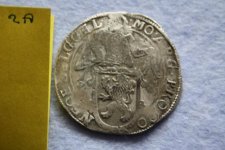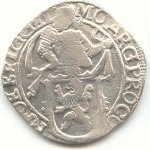edofloyd
New Member
Does anybody here have a sugestion about the value of a lion dollar?
I did found some info on it, but hard to pricetag.
My friend wants to sell it, but has no idea where to start.
here is a quote from the found text:
The obverse of the lion dollar depicts a standing knight, in front of his legs rests a shield bearing a lion in what is know as the rampant position. This lion is found on both the Dutch and Belgian coats of arms. Within two circles of beadwork around the rim is a version of the legend, MO · AR · CIVIIM · P · BELG · followed by a location such as WEST. This abbreviated Latin legend may be transcribed as: MONETA ARGENTEA CIVIIM CONFOEDERATUM BELGICARUM WEST FRISIAE (Silver money of the City of the Netherlands1 Confederation West Frisia). The reverse displays the same heraldic lion in a larger size, again there are two circles of beadwork around the rim with the motto of the United Provinces, CONFIDENS. DNO. NON. MOVETVR (Who trusts in the Lord is not moved) followed by the date. In the motto DNO is an abbreviation for DOMINO. Lion dollars were usually produced from thin planchets that did not fully fill the thickness of the dies, thus they were often weakly struck.
The lion dollar circulated throughout the Middle East and was imitated in several German and Italian cities. It was also popular in the Dutch East Indies as well as in the Dutch New Netherlands Colony (New York). The lion dollar also circulated throughout the English colonies during the Seventeenth and early Eighteenth centuries. Examples circulating in the colonies were usually fairly well worn so that the design was not fully distinguishable, thus they were sometimes referred to as "dog dollars." Larger Dutch silver coins as the ducatoon and the "rix" dollar (rijksdaalder) were also used in the colonies but neither of these coins had such a wide circulation or long lasting influence as the lion dollar.
In Maryland the lion dollar was mentioned as the most important circulating coin in documents of 1701 and 1708, with its value stated as 4s6d. It is reported by Felt (p. 250) that a deposition was taken in Boston on July 29, 1701 stating that "Dog or Lion dollars" had been counterfeited in Massachusetts. In 1708 the New York Assembly set the value of the lion dollar at 5s6d. Also, the New York paper currency emission of November 1, 1709 was issued as amounts of sterling silver expressed in denominations of 4, 8, 16 and 20 lion dollars, with 13.75 oz. of silver equal to 20 lion dollars. Mossman also states lion dollars were used in Pennsylvania, New Jersey and Virginia. In April of 1998 a Mike Cato from Virginia sent me an e-mail that he had discovered a 1640 lion dollar while metal detecting. In the hoard collected from the H.M.S. Feversham, which sank on October 7, 1711 after leaving New York, there were 22 lion dollars (quantitatively third only to the 504 Spanish Colonial silver coins and the 126 specimens of Massachusetts silver). Also, two lion dollars were inventoried in the hoard discovered in Castine, Maine, thought to have been deposited there in 1704 by French colonists fleeing from the English. It should be recalled that most of the Castine hoard was dispersed before an inventory could be produced.
Regards, max.
Foto's are the objects available.
We mainly want to know, if this is part of usa history too?
Note: this figure is looking to the oposite direction, and arms are also reversed, this means it was for foreign trade only
I did found some info on it, but hard to pricetag.
My friend wants to sell it, but has no idea where to start.
here is a quote from the found text:
The obverse of the lion dollar depicts a standing knight, in front of his legs rests a shield bearing a lion in what is know as the rampant position. This lion is found on both the Dutch and Belgian coats of arms. Within two circles of beadwork around the rim is a version of the legend, MO · AR · CIVIIM · P · BELG · followed by a location such as WEST. This abbreviated Latin legend may be transcribed as: MONETA ARGENTEA CIVIIM CONFOEDERATUM BELGICARUM WEST FRISIAE (Silver money of the City of the Netherlands1 Confederation West Frisia). The reverse displays the same heraldic lion in a larger size, again there are two circles of beadwork around the rim with the motto of the United Provinces, CONFIDENS. DNO. NON. MOVETVR (Who trusts in the Lord is not moved) followed by the date. In the motto DNO is an abbreviation for DOMINO. Lion dollars were usually produced from thin planchets that did not fully fill the thickness of the dies, thus they were often weakly struck.
The lion dollar circulated throughout the Middle East and was imitated in several German and Italian cities. It was also popular in the Dutch East Indies as well as in the Dutch New Netherlands Colony (New York). The lion dollar also circulated throughout the English colonies during the Seventeenth and early Eighteenth centuries. Examples circulating in the colonies were usually fairly well worn so that the design was not fully distinguishable, thus they were sometimes referred to as "dog dollars." Larger Dutch silver coins as the ducatoon and the "rix" dollar (rijksdaalder) were also used in the colonies but neither of these coins had such a wide circulation or long lasting influence as the lion dollar.
In Maryland the lion dollar was mentioned as the most important circulating coin in documents of 1701 and 1708, with its value stated as 4s6d. It is reported by Felt (p. 250) that a deposition was taken in Boston on July 29, 1701 stating that "Dog or Lion dollars" had been counterfeited in Massachusetts. In 1708 the New York Assembly set the value of the lion dollar at 5s6d. Also, the New York paper currency emission of November 1, 1709 was issued as amounts of sterling silver expressed in denominations of 4, 8, 16 and 20 lion dollars, with 13.75 oz. of silver equal to 20 lion dollars. Mossman also states lion dollars were used in Pennsylvania, New Jersey and Virginia. In April of 1998 a Mike Cato from Virginia sent me an e-mail that he had discovered a 1640 lion dollar while metal detecting. In the hoard collected from the H.M.S. Feversham, which sank on October 7, 1711 after leaving New York, there were 22 lion dollars (quantitatively third only to the 504 Spanish Colonial silver coins and the 126 specimens of Massachusetts silver). Also, two lion dollars were inventoried in the hoard discovered in Castine, Maine, thought to have been deposited there in 1704 by French colonists fleeing from the English. It should be recalled that most of the Castine hoard was dispersed before an inventory could be produced.
Regards, max.
Foto's are the objects available.
We mainly want to know, if this is part of usa history too?
Note: this figure is looking to the oposite direction, and arms are also reversed, this means it was for foreign trade only




